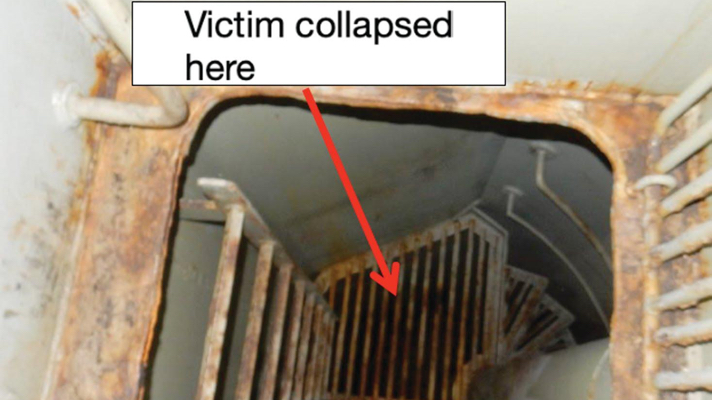Never go into an enclosed space to save a victim unless you are equipped with full breathing apparatus equipment. Although most seafarers know the risks of entering enclosed spaces, accidents still abound, such as the one reported by the latest Mars Reports.
Mars reports about a stevedore entering an enclosed space and falling unconscious. His would-be rescuers, fell into the same trap. A transcript of the incident:
A bulk carrier was in port. A safety and unloading meeting was held between the port production co-ordinator and the ship’s crew, and the stevedores began to discharge the cargo of coal. During the meeting, the master pointed out that the vessel had enclosed “Australian” hold access ladders (with intermediate platforms at certain points), so there was a risk of oxygen deficiency in these spaces. It was stated that stevedores should access the holds via the unenclosed straight ladders, which could be accessed via booby hatches that would be opened by the crew.
Unloading proceeded all day. In the evening, a new stevedore gang was brought on board. The handover between the two stevedore gangs was unstructured and the information that the stevedores were not to use the Australian ladders went unmentioned.
Stevedore A was to drive the loader in hold 7. He proceeded to enter the hold through the Australian ladder access. When the supervisor did not see stevedore A come into the hold he tried to radio him, but there was no answer. He went to the Australian ladder entrance and saw the victim laying on the first platform below the hatch.
Rescuers Faint Too
The supervisor entered the enclosed ladder space to help the victim and called on the radio for help. As he came near the victim he felt weak and dizzy; as he tried to escape he fainted. Another stevedore arrived and was able to extricate the supervisor. He then descended to try and help the first victim, but this time he too fainted. A third stevedore arrived with an emergency escape breathing device (EEBD) and, after speaking with the recovering supervisor, entered the space and extricated the second victim.
As word of the emergency spread, ship’s crew arrived with breathing apparatus (BA) equipment and the first victim was extricated using a rope. CPR was administered, but he was later declared dead.
Report Findings
Some of the official findings within the report were as follows:
- The stevedores did not use personal gas meters.
- No gas measurement was made in the cargo spaces before unloading began.
- Handovers from one stevedore gang to the next were not sufficiently structured, so some safety-critical information was not passed on.
Lessons Learned
- Workers in any enclosed space should have personal gas meters with them. Those spaces should also be tested prior to entry.
- All access points to holds should be controlled by ship’s crew and kept locked when their use is unauthorised.
- Never go into an enclosed space to save a victim unless you are part of a team and equipped with full BA equipment (not EEBD).
Mars Reports
This is one of the May Mars Reports, originally published as Mars 201941, that are part of Report Number 321. A selection of this Report has also been published in SWZ|Maritime’s July/August issue.
Submit a Mars Report
More reports are needed to keep the scheme interesting and informative. All reports are read only by the Mars coordinator and are treated in the strictest confidence. To submit a report, please use the Mars report form and send it to mars@nautinst.org.








